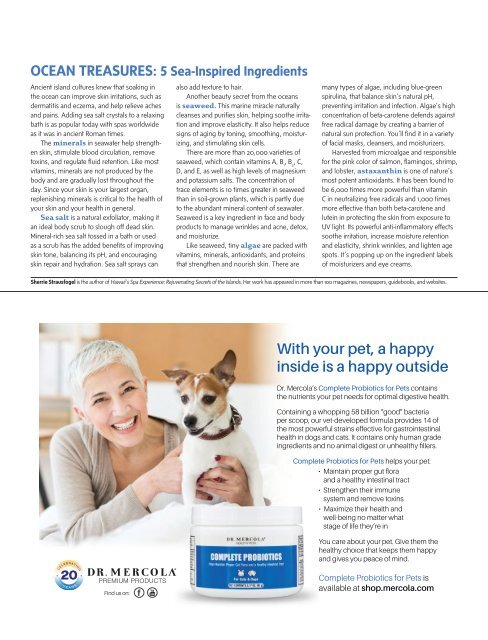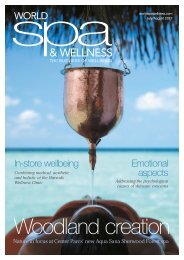Better Nutrition August 2017
Create successful ePaper yourself
Turn your PDF publications into a flip-book with our unique Google optimized e-Paper software.
OCEAN TREASURES: 5 Sea-Inspired Ingredients<br />
Ancient island cultures knew that soaking in<br />
the ocean can improve skin irritations, such as<br />
dermatitis and eczema, and help relieve aches<br />
and pains. Adding sea salt crystals to a relaxing<br />
bath is as popular today with spas worldwide<br />
as it was in ancient Roman times.<br />
The minerals in seawater help strengthen<br />
skin, stimulate blood circulation, remove<br />
toxins, and regulate fluid retention. Like most<br />
vitamins, minerals are not produced by the<br />
body and are gradually lost throughout the<br />
day. Since your skin is your largest organ,<br />
replenishing minerals is critical to the health of<br />
your skin and your health in general.<br />
Sea salt is a natural exfoliator, making it<br />
an ideal body scrub to slough off dead skin.<br />
Mineral-rich sea salt tossed in a bath or used<br />
as a scrub has the added benefits of improving<br />
skin tone, balancing its pH, and encouraging<br />
skin repair and hydration. Sea salt sprays can<br />
also add texture to hair.<br />
Another beauty secret from the oceans<br />
is seaweed. This marine miracle naturally<br />
cleanses and purifies skin, helping soothe irritation<br />
and improve elasticity. It also helps reduce<br />
signs of ag ing by toning, smoothing, moisturizing,<br />
and stimulating skin cells.<br />
There are more than 20,000 varieties of<br />
seaweed, which contain vitamins A, B 1<br />
, B 2<br />
, C,<br />
D, and E, as well as high levels of magnesium<br />
and potassium salts. The concentration of<br />
trace elements is 10 times greater in seaweed<br />
than in soil-grown plants, which is partly due<br />
to the abundant mineral content of seawater.<br />
Seaweed is a key ingredient in face and body<br />
products to manage wrinkles and acne, detox,<br />
and moisturize.<br />
Like seaweed, tiny algae are packed with<br />
vitamins, minerals, antioxidants, and proteins<br />
that strengthen and nourish skin. There are<br />
many types of algae, including blue-green<br />
spirulina, that balance skin’s natural pH,<br />
preventing irritation and infection. Algae’s high<br />
concentration of beta-carotene defends against<br />
free radical damage by creating a barrier of<br />
natural sun protection. You’ll find it in a variety<br />
of facial masks, cleansers, and moisturizers.<br />
Harvested from microalgae and responsible<br />
for the pink color of salmon, flamingos, shrimp,<br />
and lobster, astaxanthin is one of nature’s<br />
most potent antioxidants. It has been found to<br />
be 6,000 times more powerful than vitamin<br />
C in neutralizing free radicals and 1,000 times<br />
more effective than both beta-carotene and<br />
lutein in protecting the skin from exposure to<br />
UV light. Its powerful anti-inflammatory effects<br />
soothe irritation, increase moisture retention<br />
and elasticity, shrink wrinkles, and lighten age<br />
spots. It’s popping up on the ingredient labels<br />
of moisturizers and eye creams.<br />
Sherrie Strausfogel is the author of Hawaii’s Spa Experience: Rejuvenating Secrets of the Islands. Her work has appeared in more than 100 magazines, newspapers, guidebooks, and websites.<br />
f






